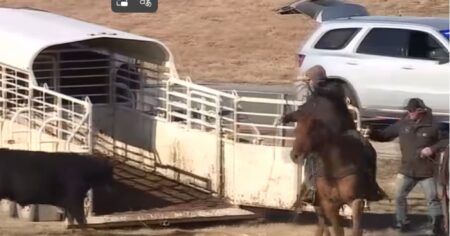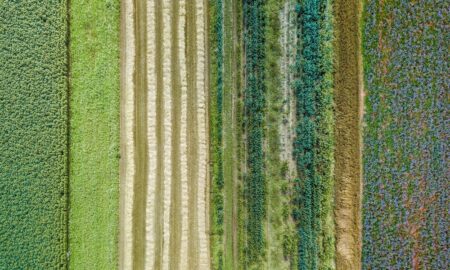As the chief economist for the National Corn Growers Association (NCGA), Krista Swanson studies ag markets and policy for a living, but she also has skin in the game as an Illinois corn and soybean grower, farming alongside her husband, Brett, and his family.
“My strengths or skill set works well for the bookkeeping and financial type of decisions, so that’s where my biggest involvement is on the farm,” she said. “I was a Corn Growers member before I was a staff person, so that definitely helps make me relatable to our growers, and it makes it personal for me.”
15 Minutes With Krista Swanson
Where Do We Stand?
Swanson said farmers and many of those outside the industry have a very different view of the current farm economy.
USDA’s September farm income forecast showed expected income 25% higher than last year. “For folks outside of agriculture or people in our D.C. offices, if they see that headline or umber, then the perception is that the farm economy is really strong,” she said.
On the other side of the coin, last month’s NCGA survey of more than 1,000 corn growers showed 76% of respondents are very or moderately concerned about the farm economy, 85% feel we are on the brink of or heading toward a farm crisis, and 65% are more concerned about their farm’s finances than they were a year ago.
One reason for this disconnect, she said, is USDA’s forecast includes the livestock sector and ad hoc support in the form of disaster aid, farm program payments, and crop insurance. “All of those things added together paints a very different picture than just looking at costs and returns in the crop sector,” Swanson said.
Those ad hoc payments skew the perception of income. “That money is generally not staying in farmers’ pockets. They’re going to use it to pay their input bills or pay down an operating loan so they can turn around and pay whatever bills that they have,” she said. “That is going to continue to also help some of those agricultural retailers, shops and rural economies. There is a flow-through effect that happens as opposed to just going to the farmers.”
Is It the 1980s All Over Again?
The current financial climate has some parallels with another difficult chapter for farmers. “No one in agriculture likes to make a comparison to the 1980s, but we’re in a really high-cost environment right now, which was also true to that period from the mid ’70s to the mid ’80s, and in fact, when you adjust from a nominal perspective, we’ve been at record high production costs by a long shot since 2022,” Swanson said.
She said farmers find themselves in a Catch-22 because inputs and other expenses are correlated with inflation over long periods of time, but the prices farmers receive for their crops is not. “Inflation is driving all of those types of inputs higher,” she said, “but for a commodity like corn especially, it’s primarily driven on supply and demand.”
Swanson said she’s noticing red flags including weakening in terms of loan repayments, farmer debt levels relative to assets, and a cumulative drop in negative net returns between 2023 and 2025 that is the sharpest relative drop back to when that data set began in 1975. “It costs a lot more to do business today — the amount of money that it takes to put in a crop on an average farm,” she said. “So when you think bout the risk potential that’s out there and the sharpness of that drop, I think those are two things that are definitely concerning.”
What’s the Answer?
Still, Swanson said, there are bright spots. “We don’t have interest rates that are comparable to the ’80s,” she said. “The global market continues to have a lot of potential and we’re much more globalized and connected as a world than we were [in the 1980s]. There has been evolution in a lot of places and there are market opportunities out there.”
Swanson said NCGA’s message to Congress and the administration is that what most farmers really want is a competitive market for their product. “We need to break down some policy barriers with some real changes. It’s nice to get a trade agreement that has some purchase commitments in it, but there are some nations where there’s a lot of market potential and there’s other types of barriers such as they won’t use corn-based ethanol in their fuel; they’ll only use it for industrial uses or they won’t take it. There are biotech-based products we know scientifically are proven to be safe, there’s phytosanitary, and there’s a whole slew of different types of what we call non-tariff barriers, and so what we really want or need is is breaking through some of those.”
There’s room for domestic demand growth as well, Swanson said, citing policy barriers preventing year-round or higher blends of ethanol and the affordable use of renewable aviation fuel. “None of these are a one-and-done answer. It’s going to be a collective approach that takes time, but I think there are opportunities out there,” she said.
What Can Farmers Do?
“Challenging times can cause us to be distracted and anxious and can keep us from staying focused on our goals,” Swanson said. She offered three tips for farmers:
- Know your numbers and focus on controllables. “Keep good records. If you really want to hone in on your controllables or figure out where you could make adjustments to your business in a challenging time, you have to keep good track of things to start with.”
- Be consistent. “Sometimes it’s easy to get discouraged and feel like in tough, challenging times, it’s hard to make a big move, but remember that small steps can be easier in a tough environment and small steps compound over time,” she said. “Agriculture is an industry that’s going to keep progressing, so as a farmer, you need to keep up with that, too. I think it’s more important than ever not to be stagnant.” For example, she said, if you’re saving for a piece of land, you may not be able to set aside as much as you would’ve liked, but maybe you can do smaller amounts. Or if you have technology goals, just add one thing this year.
- Have courage. Swanson encouraged farmers to have the courage to make hard decisions, and to get involved with NCGA or other organizations and have the courage to act and share ideas. She also advised farmers to have conversations with others. “You can communicate and have the opportunity to talk with people who sometimes don’t understand agriculture because they’re removed from it, so have the courage to have coffee with a neighbor and share about that too,” she said.
Swanson reiterated that while times are certainly tough, there are bright spots and opportunities. She said, “We have to really come together as an industry and support each other and work together to try to get the right people in the right places to make things happen.”
Episode Highlights
- Swanson said farm income headlines mask crop-sector stress once ad hoc aid and livestock are stripped out.
- An NCGA grower survey showed widespread concern and rising financial anxiety versus last year.
- Swanson contrasted today with the 1980s, pointing to lower interest rates but sharper recent margin compression.
- Swanson stressed that commodity prices don’t track inflation, while inputs do over time.
- Swanson urged farmers to focus on controllables: accurate records, consistency in small steps, and courage in hard calls.
- She noted domestic opportunities in higher ethanol blends and sustainable aviation fuel, but said we must remove non-tariff barriers in international markets.
Links and Resources
Listen to the Podcast
Subscribe to 15 Minutes With a Farmer on Apple Podcasts, Spotify, or wherever you listen to podcasts. Please rate and review us!









:max_bytes(150000):strip_icc()/soybeans-down-7d23272bd031487b908c22b63639473a.jpeg)

:max_bytes(150000):strip_icc()/MayWheatRainDrops-1-731120a608ab4b9c8576aeff53d5ff5f.jpg)
